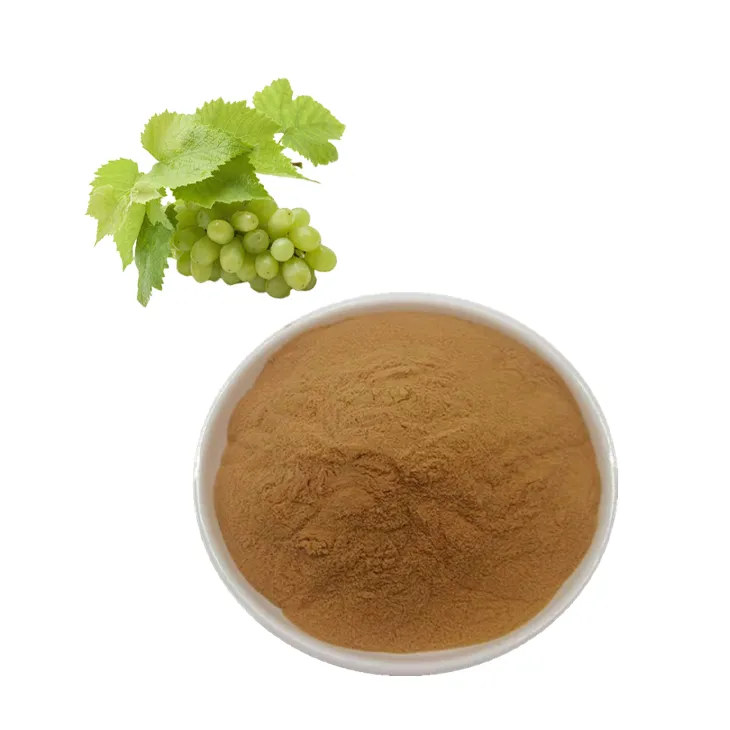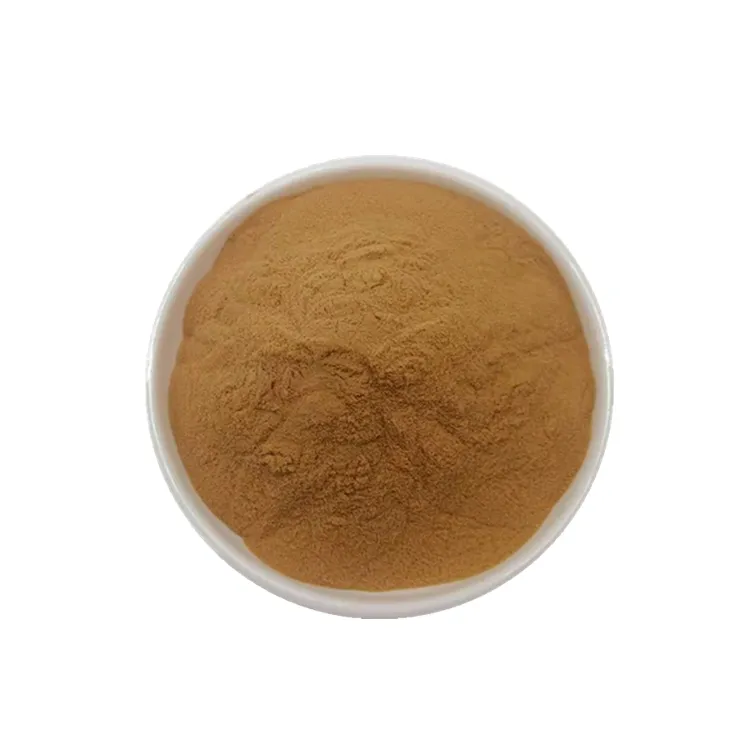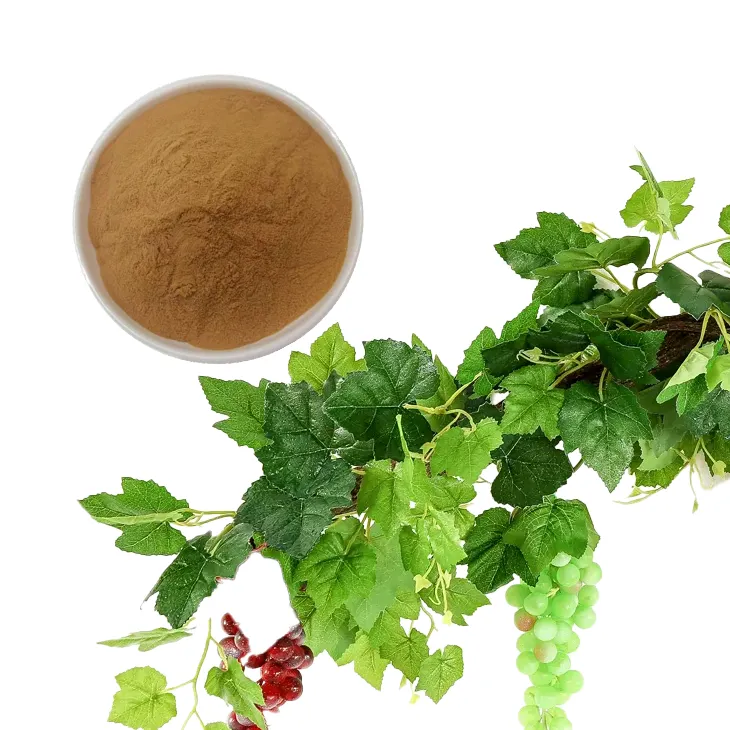- 0086-571-85302990
- sales@greenskybio.com
Best Grape Leaf Extract: A Guide to Selecting the Finest Grape Leaf Extract
2024-11-12

1. Introduction
Grape Leaf Extract has been gaining popularity in recent years due to its potential health benefits. However, not all Grape Leaf Extracts are created equal. The quality can vary significantly, depending on various factors. This article aims to provide a comprehensive guide on how to select the best Grape Leaf Extract by considering its chemical composition, potential side effects, and effectiveness.

2. Chemical Composition of Grape Leaf Extract
2.1 Polyphenols
Polyphenols are one of the most important components in grape leaf extract. These are a group of chemical substances that include flavonoids, phenolic acids, and stilbenes. Flavonoids, such as Quercetin and kaempferol, are known for their antioxidant properties. They help in neutralizing free radicals in the body, which can cause oxidative stress and damage to cells. Phenolic acids, like caffeic acid and ferulic acid, also contribute to the antioxidant activity of the extract. Stilbenes, with resveratrol being the most well - known, have been associated with various health benefits including anti - inflammatory and anti - cancer properties.
2.2 Minerals
Grape leaf extract also contains essential minerals. For example, it is a source of potassium, which is important for maintaining proper heart function and regulating blood pressure. Magnesium is another mineral present in grape leaf extract, and it is involved in numerous enzymatic reactions in the body, including those related to energy production and muscle function. Calcium, though in relatively smaller amounts compared to other sources, can also contribute to bone health.
2.3 Vitamins
Some vitamins are found in grape leaf extract as well. Vitamin C, an antioxidant vitamin, can help boost the immune system and is also involved in collagen synthesis. Vitamin K, which is important for blood clotting, is also present. However, the amounts of these vitamins may not be as high as in other food sources, but they still contribute to the overall nutritional value of the extract.

3. Potential Health Benefits of Grape Leaf Extract
3.1 Anti - inflammatory Effects
The polyphenols in grape leaf extract, particularly flavonoids, have anti - inflammatory properties. Inflammation is a natural response of the body to injury or infection, but chronic inflammation can lead to various diseases such as arthritis, heart disease, and diabetes. By reducing inflammation, grape leaf extract may help in preventing or managing these conditions. For example, in a study on animals, it was observed that grape leaf extract reduced the levels of inflammatory markers in the body.
3.2 Antioxidant Activity
As mentioned earlier, the polyphenols in grape leaf extract act as antioxidants. Free radicals are constantly produced in the body during normal metabolic processes, and exposure to environmental factors such as pollution and UV radiation can also increase their production. These free radicals can damage cells, DNA, and proteins. The antioxidant activity of grape leaf extract helps in scavenging these free radicals, thereby protecting the body from oxidative damage. This can potentially reduce the risk of developing cancer, heart disease, and neurodegenerative diseases.
3.3 Cardiovascular Health
The potassium in grape leaf extract can help in lowering blood pressure. High blood pressure is a major risk factor for heart disease. Additionally, the antioxidant and anti - inflammatory properties of the extract may also help in reducing the risk of atherosclerosis, which is the build - up of plaque in the arteries. Some studies have suggested that grape leaf extract can improve lipid profiles by reducing LDL (low - density lipoprotein) cholesterol levels and increasing HDL (high - density lipoprotein) cholesterol levels.
3.4 Blood Sugar Regulation
There is some evidence to suggest that grape leaf extract may play a role in regulating blood sugar levels. It may improve insulin sensitivity, which is important for the proper utilization of glucose in the body. In diabetic patients or those at risk of developing diabetes, this could be beneficial in managing blood sugar levels. However, more research is needed to fully understand the mechanisms involved.

4. Potential Side Effects of Grape Leaf Extract
While grape leaf extract has many potential health benefits, it is also important to be aware of its potential side effects.
4.1 Gastrointestinal Disturbances
Some people may experience gastrointestinal side effects such as nausea, vomiting, diarrhea, or abdominal pain after taking grape leaf extract. These side effects are usually mild and may occur if the extract is taken in large doses or if a person has a sensitive stomach. It is recommended to start with a small dose and gradually increase it to see how the body reacts.
4.2 Allergic Reactions
Allergic reactions to grape leaf extract are rare but possible. People who are allergic to grapes may also be allergic to grape leaf extract. Symptoms of an allergic reaction may include rash, itching, swelling, difficulty breathing, or anaphylaxis in severe cases. If any of these symptoms occur after taking grape leaf extract, it should be discontinued immediately and medical attention should be sought.
4.3 Interaction with Medications
Grape leaf extract may interact with certain medications. For example, it may potentiate the effects of blood - thinning medications such as warfarin. This could increase the risk of bleeding. It is important to inform your healthcare provider if you are taking grape leaf extract, especially if you are on any medications.
5. Factors to Consider When Selecting Grape Leaf Extract
5.1 Source and Quality of Grapes
The quality of grape leaf extract depends largely on the source of the grapes. Grapes that are grown organically are generally preferred as they are less likely to be contaminated with pesticides and other chemicals. Additionally, the variety of grapes can also affect the composition of the extract. For example, different grape varieties may have different levels of polyphenols. Some well - known grape varieties used for extract production include Vitis vinifera.
5.2 Extraction Method
The method used to extract the active compounds from the grape leaves can significantly impact the quality of the extract. There are several extraction methods, including solvent extraction, supercritical fluid extraction, and microwave - assisted extraction. Solvent extraction is the most commonly used method, but the choice of solvent can affect the purity and composition of the extract. Supercritical fluid extraction, using substances like carbon dioxide in a supercritical state, can produce a more pure and high - quality extract, but it is also more expensive. Microwave - assisted extraction is a relatively new method that can be more efficient in terms of time and energy, but further research is needed to fully understand its impact on the quality of the extract.
5.3 Purity and Concentration
When selecting a grape leaf extract, it is important to consider its purity and concentration. A high - quality extract should have a high concentration of the active compounds such as polyphenols. However, it should also be free from contaminants such as heavy metals, pesticides, and other impurities. Look for products that have been tested for purity by independent laboratories and have a clear indication of the concentration of the active ingredients.
5.4 Brand Reputation
The reputation of the brand is also an important factor. Choose a brand that has a good track record in producing high - quality supplements. Read customer reviews and look for brands that are transparent about their manufacturing processes and ingredient sourcing. Brands that are members of industry associations or have certifications such as GMP (Good Manufacturing Practice) are generally more reliable.
6. How to Use Grape Leaf Extract
Once you have selected the best grape leaf extract, it is important to know how to use it properly.
6.1 Dosage
The appropriate dosage of grape leaf extract can vary depending on various factors such as age, health condition, and the purpose of use. In general, it is recommended to start with a low dose, such as 100 - 200 mg per day, and gradually increase it if needed. However, it is always best to consult a healthcare provider before starting any new supplement, especially if you have any underlying health conditions or are taking medications.
6.2 Mode of Administration
Grape leaf extract is available in various forms, including capsules, tablets, and liquid extracts. Capsules and tablets are convenient for daily use, while liquid extracts may be absorbed more quickly by the body. The choice of mode of administration depends on personal preference and convenience.
6.3 Duration of Use
The duration of use of grape leaf extract also depends on the individual's health goals. For short - term benefits such as reducing inflammation or improving antioxidant status, it may be used for a few weeks to a few months. However, for long - term health benefits such as cardiovascular protection or blood sugar regulation, it may need to be used continuously over a longer period of time. But again, it is important to monitor any potential side effects during long - term use and consult a healthcare provider regularly.
7. Conclusion
Grape leaf extract has the potential to offer many health benefits, but choosing the best one requires careful consideration of its chemical composition, potential side effects, and effectiveness. By taking into account factors such as the source of grapes, extraction method, purity, concentration, and brand reputation, you can select a high - quality grape leaf extract. Additionally, it is important to use the extract properly, following the recommended dosage, mode of administration, and duration of use. With the right selection and proper use, grape leaf extract can be a valuable addition to a healthy lifestyle.
FAQ:
What factors should be considered when choosing grape leaf extract?
When choosing grape leaf extract, several factors should be considered. Firstly, the chemical composition is crucial. Look for extracts with a high content of beneficial compounds such as flavonoids and phenolic acids, which are associated with various health benefits. Secondly, consider the effectiveness. Check for scientific studies or customer reviews that indicate its efficacy in areas like improving cardiovascular health or reducing inflammation. Additionally, potential side effects need to be taken into account. Make sure the extract has been tested for safety and has minimal adverse effects. The source of the grape leaves and the extraction method also matter. High - quality grape leaves from a clean and sustainable source, along with a proper extraction process that preserves the active compounds, are more likely to result in a superior extract.
How can one determine the chemical composition of grape leaf extract?
To determine the chemical composition of grape leaf extract, one can refer to the product label if available. However, for a more detailed and accurate analysis, laboratory testing is required. Sophisticated techniques such as high - performance liquid chromatography (HPLC) and mass spectrometry can be used to identify and quantify the various compounds present in the extract, including flavonoids, phenolic acids, and other bioactive substances. Some manufacturers may also provide certificates of analysis from third - party laboratories, which can give an indication of the chemical composition.
What are the potential health benefits of grape leaf extract?
Grape leaf extract has several potential health benefits. It may contribute to cardiovascular health by helping to lower blood pressure and improve blood lipid profiles. The flavonoids and other antioxidants in the extract can also reduce oxidative stress and inflammation in the body. There is some evidence to suggest that it may have a positive impact on blood sugar control, which could be beneficial for people with diabetes or at risk of developing diabetes. Additionally, grape leaf extract may have antimicrobial and anti - fungal properties, although more research is needed to fully understand these effects.
Are there any side effects associated with grape leaf extract?
While grape leaf extract is generally considered safe for most people, there can be some potential side effects. In some cases, it may cause mild gastrointestinal discomfort such as nausea, vomiting, or diarrhea, especially if taken in large amounts. People who are allergic to grapes or related products may also experience an allergic reaction to the extract. Additionally, since grape leaf extract may have an impact on blood pressure and blood sugar, those with pre - existing medical conditions such as hypotension (low blood pressure) or hypoglycemia (low blood sugar) should use it with caution and under the guidance of a healthcare professional.
How can the effectiveness of grape leaf extract be measured?
The effectiveness of grape leaf extract can be measured in several ways. In vitro studies can be conducted in a laboratory setting to observe the extract's impact on cells, such as its antioxidant or anti - inflammatory effects on cultured cells. Animal studies are also commonly used to assess the effects on physiological parameters like blood pressure, blood sugar, and lipid levels in animal models. In human studies, clinical trials are the gold standard. These trials may measure objective outcomes such as changes in blood pressure, blood lipid profiles, or blood sugar levels over a period of time. Subjective measures such as self - reported symptoms related to inflammation or cardiovascular health can also be considered.
Related literature
- The Chemical Composition and Biological Activities of Grape Leaf Extract"
- "Evaluating the Efficacy and Safety of Grape Leaf Extract in Cardiovascular Health"
- "A Review of the Potential Health Benefits of Grape - Derived Compounds, including Grape Leaf Extract"
- ▶ Hesperidin
- ▶ citrus bioflavonoids
- ▶ plant extract
- ▶ lycopene
- ▶ Diosmin
- ▶ Grape seed extract
- ▶ Sea buckthorn Juice Powder
- ▶ Beetroot powder
- ▶ Hops Extract
- ▶ Artichoke Extract
- ▶ Reishi mushroom extract
- ▶ Astaxanthin
- ▶ Green Tea Extract
- ▶ Curcumin Extract
- ▶ Horse Chestnut Extract
- ▶ Other Problems
- ▶ Boswellia Serrata Extract
- ▶ Resveratrol Extract
- ▶ Marigold Extract
- ▶ Grape Leaf Extract
- ▶ blog3
- ▶ blog4
- ▶ blog5
-
Organic Tongkat Ali extract powder factory.
2024-11-12
-
How to make powder with ashwagandha extract.
2024-11-12
-
Rosehip extract manufacturers from China.
2024-11-12
-
The best cat's claw extract in nature.
2024-11-12
-
Chinese Dandelion Leaf Extract Suppliers.
2024-11-12
-
Nettle Root Extract
2024-11-12
-
Jujube Extract
2024-11-12
-
Curcuma Longa Extract/Turmeric extract
2024-11-12
-
Cat Claw Extract
2024-11-12
-
White Willow Bark Extract
2024-11-12
-
Agaricus Blazei Extract
2024-11-12
-
Berberis aristata Extract
2024-11-12
-
Chaste Berry Extract
2024-11-12
-
Grape Leaf Extract
2024-11-12
-
Chasteberry Extract
2024-11-12




















